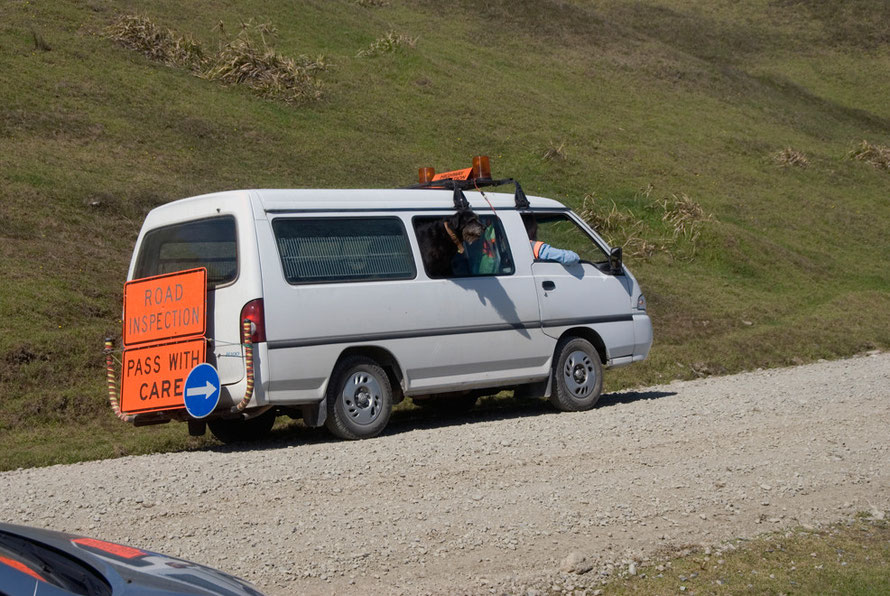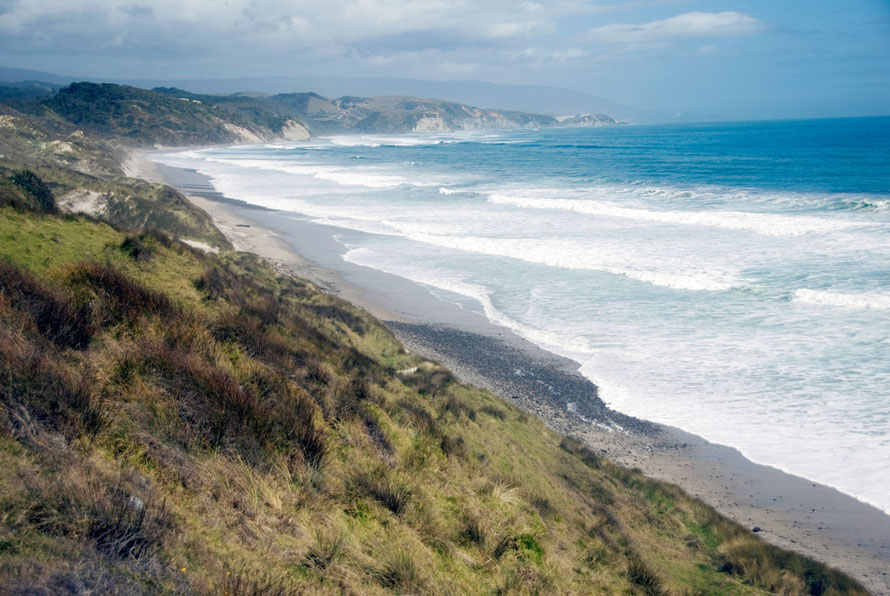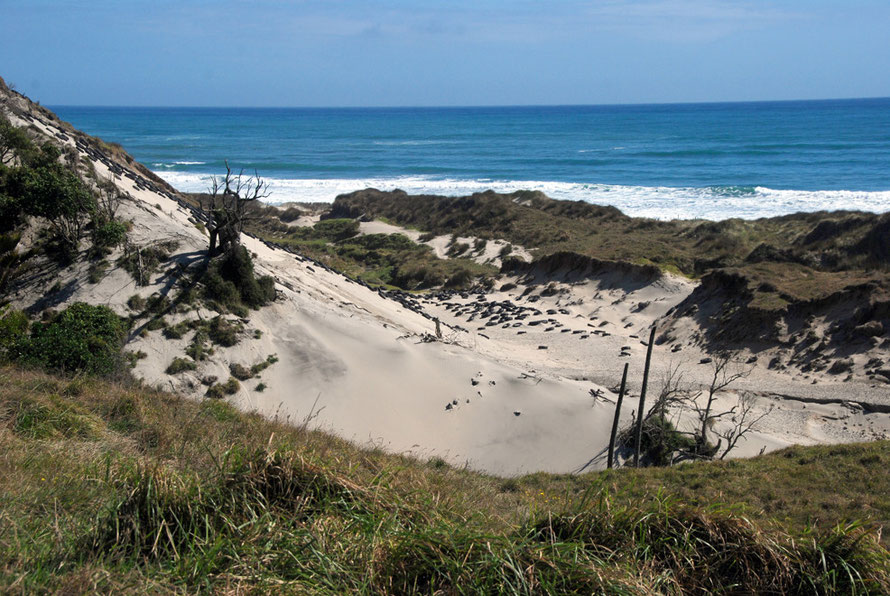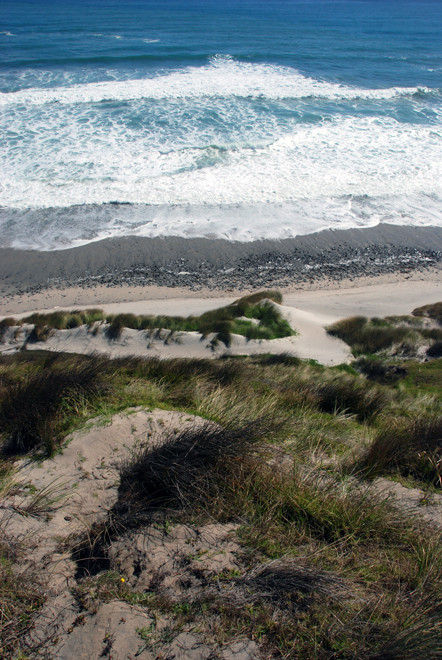Golden Bay V: To the West Coast
Back on the road I suggested, pleaded even, that maybe we could follow the gravel road another few miles. I reckoned another 4km of dusty driving would bring us to the wide-open, glittering, surfy Tasman Sea.
We pushed on, John and Karen following our dust-spume, to the Puturau River and the looming karst country behind it. The sun shone and the air was sweet and super-fresh: a speciality of New
Zealand.
I though we might see the sea at the Paturau rivermouth, the site of battles between different Maori iwi but a farmer-lad on a quadbike with two dogs on the back came out of the turning I'd planned to take and I pressed on across the bridge and up the incline beyond the river.

This was empty country and our supplies were non-existent. The stones on the road were getting bigger and looser. They no longer pinged off the bottom of the car's bodywork but now banged and smashed into the thin sump metal. Going uphill sounded like being in midst of a maniacal Keith Moon drum solo.
You could sense the sea beyond the low, close-cropped, seer hills. The farmer-man zoomed up the hill on the quad bike. One dog taking it easy, the other running behind.
We rushed through the increasingly spectacular karst country and drove on. The quad bike stopped and I stopped to ask the guy the way to the sea.
He was young, open faced, with dreadlocks and a carved pounamu (greenstone) stone round his neck. He was friendly, said 'Yeah, you could head on down to the Anatori River. It's pretty nice down there.'
(Perhaps this was David Richards. If so his family have farmed the Paturau coastal strip and an acreage in the Redwood Valley (just west of Nelson) since buying 500 acres at £1 an acre in 1898 - for the story of the farm see The Prow: Paturau).

We pushed on and came to a river; not the Anatori but the Otuhie. Another steep climb out of the valley bottom past sheepsheds and dark silent waters, nickau palm studding the hillside, the great limestone crags high above us.
And lo, after miles of no vehicles we came chugging up behind a white van, stones kerranging of the car and a thick layer of dust creeping through the rubber seals on the tailgate. A day-glo orange sign on the back of the van proclaimed: 'Road Inspection, Pass with Care'.
A big dog, an Irish Wolf Hound-cross, had his shaggy head stuck out the back window. And a bloke, with a big shaggy beard sat at the front driving with his wife sitting next to him. He signalled us past and shortly afterwards the sea hoved into view in the most spectacular manner. I pulled over onto a narrow verge above the crashing waves to let us take it all in.

The road inspection crew were soon upon us. It was bizarre to see a dog doing road inspection work.
I've seen them doing many things but this was a first for me. I wondered how dog communicated his assessments to the driver. Had they worked out a series of barks, whines and howls? How did doggo say, 'This section needs regrading' or 'That culvert has been washed out' or 'I need to consult those sheep in the paddock on local traffic conditions. They've been doing a survey for me'?
The sun shone. A breeze blew. The surf rolled in below us at the bottom of a sandhill. The Tasman Sea was a startling turquoise blue. Then the dazzling surf line. Then the hard packed sand and black shingle beach. Then the brilliant dusty hues of the windblown, marram-anchored dunes stretching way down the coast to where the road stopped.
To where there was nothing but mountains, sea and forest for 40 kilometres until the Heaphy Track and eventually the road up from the south. It stops at Kohaihai Bluff and Caldervale where the spur McCallums Road leads up to the Oprara limestone arch and the path to the Honeycomb Hill Caves.
Far out in the haze we could see beyond the towering dunes Kahurangi Point with its lonesome lighthouse and keeper's cottage.
It was magical, stupendous, overwhelmingly beautiful. It felt like the edge of the world. But an edge with benign of sandhills, sheep paddocks, limestone crags and gully gardens of nikau palms and a turquoise, playful sea.

There is actually a retreat further along the gravel road. We
passed a woman in a pick-up heading out that way. She gave us a wave and big broad smile. I can think of worse places to unpack your troubles.

There is a Radio NZ interview with 85 year-old Harry Richards of Paturau here about farming and his life working as a shearer, miner and farmer and playing with the Paturau Pirates rugby team, and social get togethers with a keg of beer, saveloys, sandwiches and cider.
At one pointing talking about his mother's garden at Paturau he mentions fertilising the garden with the 'dags from the sheep' - this is slang for the dried dung in their wool. In New Zealand and Australia 'dag' is an insult of endearment, much like the British 'pillock', according to this Wikipedia entry. It signifies 'someone who is, or is perceived to be, unfashionable, lacking self-consciousness about their appearance and/or with poor social skills yet affable and amusing'.
Says Harry about his daily routine when he is at Paturau - he actually lives with his wife on another farm he owns near Nelson - 'I'm a great one on weeds.' He likes to keep the
pastures clean. He has also been recognised for his conservation work fencing off the Paturau river banks near the farm to keep the cattle out. He says, 'the cattle used to heller them' and
break down the banks and reedbeds that provide cover for spawning whitebait that come up the tidal stretch of the river from the sea.
The bird singing in the background when the interview moves outside sounds very much like a European Chaffinch.
There is another article here that discusses the fearsome reputation of stock from Paturau and Turimawiwi at the local Nelson abattoir, the floods that regularly make transport difficult, the application of lime to the pastures for 'fattening tucker' since the 1970s as soil fertility started to fall and the effect of salt spray on fence and gate fittings where everything from staples to hinges has to be double galvinised otherwise it 'just falls to bits'. Harry says at the end, "I just love it down here. There is one part, up the river there, I call it the promised land, a beautiful bush valley."
There is an article here about the history of the
Te Hapu holding to the north of Paturau. There are now cottages to rent here.


